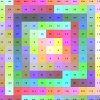Number Theory Seminar
As we saw in Gil Moss’s recent talks in the seminar, the Local Langlands Conjecture (LLC) is a certain correspondence between the set of (equivalence classes of) irreducible smooth representations of a p-adic reductive group and its set of L-parameters, i.e., certain admissible homomorphisms from the Weil group of the p-adic field to a certain complex group, called the L-group. This parameterization is to satisfy various number theoretic and representation theoretic properties involving L-functions and $\epsilon$-factors among other things, and lies, along with its global conjectural analogue, at the heart of the modern theory of automorphic forms and representations. For $GL_n$ the LLC is now a theorem, due to Michael Harris & Richard Taylor as well as Guy Henniart (around 2001) and Peter Scholze again more recently (around 2013). For symplectic and special orthogonal groups, it is a consequence of Arthur’s recent work on endoscopic classification of local and global representations of these groups.
When the group is $GL_n$ the correspondence is actually a bijection, but that is not the case for $SL_n$, for example. I will review the story for $GL_n$ vs. $SL_n$ and then report on a recent work, joint with Kwangho Choiy, establishing the Local Langlands Correspondence for small rank general spin groups and their inner forms. These are among the so-called twisted endoscopic groups for the general linear group.
